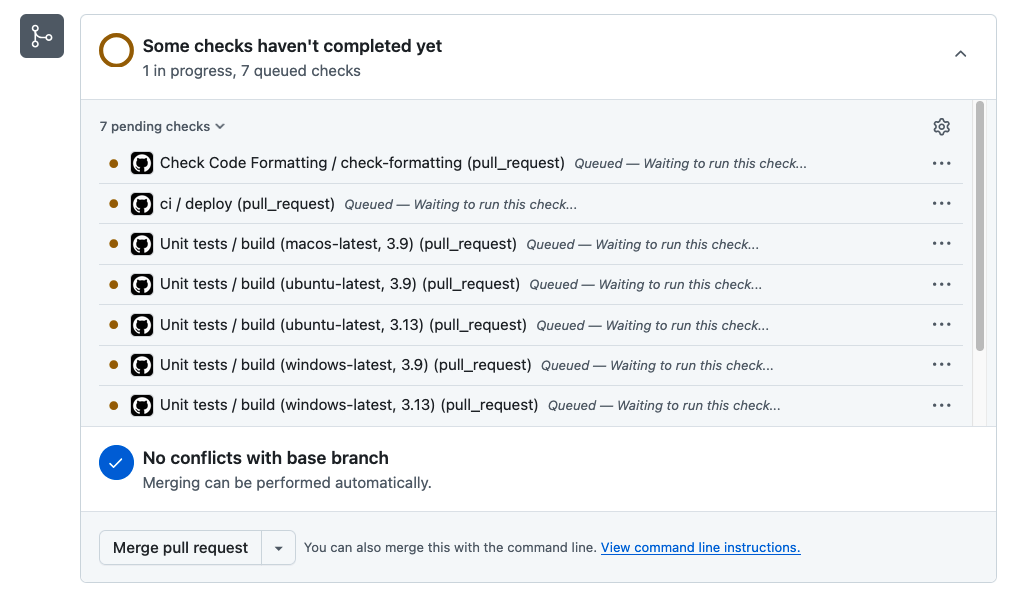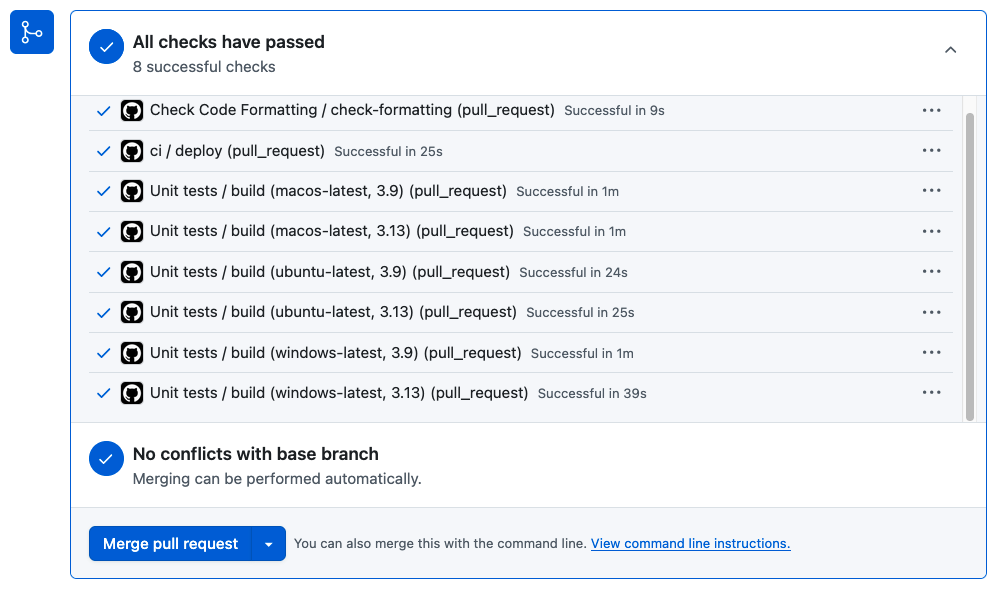8 Github Actions
Having a package implies several things, most importantly:
- creating and deploying a documentation website
- testing that it works as expected using unit tests
- tracking changes with version control (Git)
In this post, we’ll walk through 3 essential Github Actions you need in your workflow when developing Python packages.
This blog assumes basic Git/Github knowledge (push/pull, pull requests, branches).
8.1 TLDR: Github Actions
Github Actions are scripts that perform tasks (pretty much anything you want) when specific “events” occur. You can do a lot with them, but here we’ll focus on practical use cases for developing a Python package.
These scripts live in the .github/workflows/ directory and are written as yaml files. For instance, a Python package named “sunflower” with two different Github Actions might be organized like this:
sunflower/
├── sunflower/
│ ├── __init__.py
│ ├── module1.py
│ └── module2.py
├── .gitub/
│ └── workflows/
│ ├── unit-tests.yaml
│ └── code-format.yaml
├── tests/
├── .git/
├── .venv/
├── .gitignore
├── README.md
├── LICENSE
└── pyproject.tomlOn certain “events” (as defined in those scripts), unit-tests.yaml and code-format.yaml will be triggered.
The events we care about here are:w
- Opening a pull request
- Merging or pushing to the main branch
Let’s look at a practical example to understand why these scripts are important.
8.2 Unit testing
If you’re not familiar with unit testing, check out this dedicated blog post.
Suppose we have unit tests written with pytest in the tests/ directory. We can now add a unit-tests.yaml file in .github/workflows/ that looks like this:
name: Unit tests
on:
pull_request:
branches: [main]
jobs:
build:
runs-on: ${{ matrix.os }}
strategy:
matrix:
os: [ubuntu-latest, windows-latest, macos-latest]
python-version: ["3.9", "3.13"]
env:
UV_PYTHON: ${{ matrix.python-version }}
steps:
- uses: actions/checkout@v4
- name: Install uv
uses: astral-sh/setup-uv@v5
- name: Enable caching
uses: astral-sh/setup-uv@v5
with:
enable-cache: true
- name: Install the project
run: uv sync --all-groups
- name: Run tests
run: uv run pytestWhat it does:
When someone pushes a commit to a branch with an open pull request (as specified in the on section), this action will:
- install uv (a Python package manager)
- install the project dependencies using
uv sync --all-groups
- run the test suite with
uv run pytest
This runs across multiple Python versions (3.9 and 3.13) and operating systems (Windows, macOS, and Linux). That gives us 6 combinations in total (2 Python versions × 3 OSes).
Here’s what shows up on the pull request while the tests are running:

If any of those combinations fail (meaning at least one test fails), you’ll see a message indicating that something didn’t work. For example, you might learn that your package fails on Windows with Python 3.9. Otherwise, you’ll see something like this:

The purpose of setting up this Github Action is to automatically and easily verify that the package works in different environments, helping ensure that only valid code is merged into the main branch.
In this example, we used just two Python versions and one set of dependencies, but this approach can be extended to test the package under many more scenarios. That way, we get a clear and precise picture of what works and what doesn’t.
8.3 Create and deploy documentation
There’s a dedicated blog post on generating and deploying documentation for your package. Check it out here.
Let’s say we’ve created our documentation website with mkdocs. We then add a deploy-site.yaml file in .github/workflows/.
Since generating the documentation website creates a large number of files, it’s not ideal to store them in version control. But how do we deploy it to Github Pages if it’s not in version control? That’s where Github Actions come in!
Now, let’s take a look at the following Github Action script:
name: ci
on:
push:
branches: [main]
permissions:
contents: write
jobs:
deploy:
runs-on: ubuntu-latest
steps:
- uses: actions/checkout@v4
- name: Configure Git Credentials
run: |
git config user.name github-actions[bot]
git config user.email 41898282+github-actions[bot]@users.noreply.github.com
- uses: actions/setup-python@v5
with:
python-version: 3.x
- run: echo "cache_id=$(date --utc '+%V')" >> $GITHUB_ENV
- uses: actions/cache@v4
with:
key: mkdocs-material-${{ env.cache_id }}
path: .cache
restore-keys: |
mkdocs-material-
- name: Install uv
uses: astral-sh/setup-uv@v5
- name: Enable caching
uses: astral-sh/setup-uv@v5
with:
enable-cache: true
- name: Install the project
run: uv sync --all-groups
- name: Deploy MkDocs
env:
GITHUB_TOKEN: ${{ secrets.GITHUB_TOKEN }}
run: uv run mkdocs gh-deploy --forceWhat it does:
When someone merges or pushes to the main branch, this action will:
- install uv (a Python package manager)
- install the project dependencies using
uv sync --all-groups
- generate the entire documentation website with
uv run mkdocs gh-deploy --force
- push the documentation website to the
gh-pagesbranch on Github
With this setup, assuming our website is deployed to Github Pages using the gh-pages branch, the documentation site is deployed automatically whenever a pull request is opened or we merge/push to the main branch. All without keeping the auto-generated files in version control.
This also removes all manual work related to building and deploying the documentation, as it’s now fully automated through this Github Action.
8.4 Code linting and formatting
When working on a project, it’s crucial to maintain standardized coding practices:
- Consistent formatting (e.g., indentation, spacing, quotes)
- Clean code free of unused imports, bad patterns, or minor bugs
This is where code formatting and linting tools come into play, and we can automate them using Github Actions.
We’ll use ruff here, which is a super fast linter and formatter for Python. It can both check for issues (like flake8 or pylint) and format code (like black), all in one tool.
8.4.1 Add Ruff to your project
First, add Ruff as a development dependency:
uv add --dev ruff8.4.2 Create the GitHub Action
Now, create a file named .github/workflows/code-format.yaml with the following content:
name: Ruff lint and format
on:
pull_request:
branches: [main]
jobs:
lint:
runs-on: ubuntu-latest
steps:
- uses: actions/checkout@v4
- name: Install uv
uses: astral-sh/setup-uv@v5
- name: Enable caching
uses: astral-sh/setup-uv@v5
with:
enable-cache: true
- name: Install dependencies
run: uv sync --all-groups
- name: Check formatting
run: uv run ruff format . --check
- name: Lint code
run: uv run ruff check .What it does:
When a pull request is opened against main, this action will:
- Install your project and its development dependencies using
uv
- Check if the code is properly formatted with
ruff format . --check
- Lint the code with
ruff check .to catch any potential issues
If there’s anything wrong (such as a file needing formatting or an unused import), the action will fail, and the pull request will show a red ❌. That’s your cue to fix the code.
This ensures that all code added to the codebase is well-formatted and adheres to the established rules.
Note that there’s an additional way to enforce this called
pre-commit, and there’s a dedicated blog post on it.
8.5 FAQ
Github Actions is one of those things where you need to try it yourself to get the full picture. I recommend creating a basic Python package with documentation and tests, then testing the examples provided to see how they work.
When a Github Action is triggered, Github sets up a clean VM (virtual machine) to run your workflow. There are limits on usage, but they’re quite generous before you’ll need to enter your credit card details.